See what I mean?! And that picture was taken out of a moving car! But actually, I'm getting ahead of myself. Let's take this chronologically.
After Machu Picchu, we went back to our hotel to rest for just a bit before getting back on the Vistadome train. This ride was even better than the first, and here's why.
Yep, that's Maren dancing on the train. They had a little show on the way back, and she got to be a part of it! And since this is so NOT her kind of thing--dancing in front of strangers--the video is even better. Sorry not sorry, Maren.
Anyway, our hotel was located in Yucay. It was night when we got there, so we just had dinner, showered (so necessary after Machu Picchu), and went to bed. I think I had alpaca steak for dinner. Nom.
When we woke up in the morning, we discovered that our hotel was beautiful!
Unfortunately (but not actually), we had to leave the beautiful hotel and head to the ruins at Moray. On the way, I took these photos of the landscape (and people).
This is a quinoa crop.
And here are some people we passed.
Moray was believed to be an agricultural research center. As you can see, the terraces were built in concentric circles. As our tour company explained, "The higher external terraces would be at a higher temperature than the inner ones and could simulate the conditions of various ecological strata of the empire."
In this photo you can see that there are some unfinished terraces. In addition, our guide said there are two other layers below this that haven't been excavated yet. Neat!
I think these stairs connecting the two terraces are really cool.
Part of these terraces were destroyed by erosion over time, and the original rocks have been piled around.
And here's the family.
From Moray there we drove to Salineras de Maras, a salt mine that dates back to pre-Inca times. It's still run by local families.
Each of the squares is its own little salt pan.
This is the view from the mine. So pretty!
You can see the squares better now. They're bigger than they look! And there are nearly 3,000 of them.
This is the water source for the mine. It comes down from a hypersaline subterranean stream.
You can see how salty the water is from the residue on the rocks above.
A closeup of the squares.
The way it works is that the water flows from the spring into the highest squares and then down into the lower-elevation squares. There's a valve to turn the water off when each square has been filled. The water then sits in the sun and slowly evaporates, leaving behind just the salt. The families that work the mine scrape the salt around to break it up and to aid in the evaporation process, and when it's done they collect the salt. Then they open the water valve and start the process over.
They let us touch some of the drying salt. Here it is on my finger!
And here's the family again!
Here's Daniel walking over one of the channels through which the water flows.
From Maras we drove to a restaurant in Urubamba called Huacatay. We saw these cows just roaming the streets when we got there.
We parked and walked over to the restaurant. Here we are waiting to go in!
When we sat down, John noticed his spoon was significantly longer than everyone else's. Phallic jokes ensued.
I ordered sweet potato ravioli in huacatay sauce. OH MAN. One of my favorite meals in Peru. And that's saying something!
After filling ourselves with delicious food, we walked to the Seminario pottery studio. We got to see some of the workers shaping pots as we took our tour.
We also got to see where they mix and dry the clay. They do it with their feet!
There was a beautiful fuschia, so I had to take a picture.
We also got to see the women painting and carving the pieces.
Our tour ended with the pieces Seminario made himself.
And then it was our turn to carve and paint! Here we all are, hard at work.
And here are the finished pieces (before firing)! Mine is the infantile duck. I suck at art, okay?
We couldn't leave the studio without buying some beautiful pieces, and then we went back to our hotel (the pretty one still). We had dinner at a restaurant just down the street, and it was good. All of the food in Peru was amazing!
The next day, we got up and drove to the ruins at Ollantaytambo. On our way we saw these crazy people sleeping in pods on the side of the mountain!
The town of Ollantaytambo was conquered by Pachacuti, who had a fortress built as his royal estate. The place we visited is called Temple Hill and was the ceremonial and religious center of Ollantaytambo.
All of the loose rocks on the ground fell down and were placed around the grass.
Terraces! Gotta love 'em. These ones actually have a name: The Terraces of Pumatallis. We climbed up the stairs to the left to get to Temple Hill.
Here's a view of the fortress from the bottom.
And, once again (because I'm a nerd), check out the carving of these stones!
We started to climb to the top, and I turned around to get this picture.
Here's a view from halfway up, looking down at the plaza (which we visited after climbing Temple Hill).
This is the Pinkuylluna, the Inca storehouses that were built into the side of the mountain.
Here we are halfway to the top.
Here you can see the walls of the fortress.
Once again, crazy rock cutting and building!
These little parts jutting out were handles the Incas used to carry and lift the rocks. So cool!
A pretty doorway. If I recall, the height of the stair leading up to it indicates it was meant for religious leaders and other important people.
View from the top.
This photo shows how they moved the huge rocks around. They pulled them up the hill by rolling them on logs!
And this cool rock was carved into a seat!
Just beyond these stones is one of the most important buildings at this site: El Templo del Sol. It was never actually finished, but it's very famous for this one particular part--the Wall of the Six Monoliths.
Here is a closeup of the wall. It's another feat of engineering! Historians don't know why the thin strips of rock were placed between the monoliths (which were 50 tons each!), but the construction is so solid that not even a sheet of paper could fit in the cracks.
On the wall, if you look closely, you can see the sign of the Southern Cross, or the Chakana.
This was our view from there.
Back on the ground, we went to visit the Templo del Agua.
Here it is from the front.
Here is the fountain inside the temple.
Of course I also had to show the view of the terraces from inside the temple.
And here are the Princess Baths just outside the Templo del Agua.
Daniel went to the side of the temple and discovered that there were more fountains.
See the rock above? Daniel got a photo of the top of it, which shows the channels through which the water flows. I'm sad I missed it!
On our way to the next stop, we grabbed some lunch. We avoided the touristy places and went to a restaurant our guide knew about. We told him we wanted to try cuy, and he said he knew a place. Oh, if you're wondering, this is cuy:
Yep, we ate guinea pig! This is what it looked like when it was cut up. My favorite is the little paw sticking out of the middle.
First bite!
As for how it tastes, it wasn't bad. But it wasn't good. It was like greasy chicken. And there was very little edible meat on the thing.
We found out when we were finished that there's a tradition--much like the wishbone tradition we have for Thanksgiving--in which you look for the atuqcha, or "little fox," a small bone in the guinea pig's head. We're talking this small:
Yeah, that's a pea next to it! Tradition has it that after the bone is found, you put it in a glass of beer and pass it around for everyone to drink. Whoever gets the bone in their gulp is supposed to be granted good luck. We didn't participate in that part of the tradition. But I spent a good amount of time digging in that thing's skull! Our guide was the one to find the bone though.
After our interesting lunch, we drove the rest of the way to Pisac. We parked and walked to the ruins, and on the way we stopped for some delicious empanadas. Look at all the pretty grains!
This is the oven the woman baked them in. Notice anything interesting?
Yep, there's a cat on top. Good way to keep warm!
We continued walking through the streets of Pisac and saw these water drainage channels everywhere. They date back to the Incas, if I recall.
We finally got to the site of the ruins, and this was the view! Such a beautiful place.
And here are the ruins themselves. This is where we started the tour, about halfway up the mountain, where the mud houses are.
Oh, and who could forget the terraces? Of course they have those!
As we walked up, our guide told us about the Incan Quipu. It's a system of knotted, colored ropes that was used for data and record-keeping. The cords used a base ten number system. Truth be told, I don't understand it at all! But it's cool anyway.
We continued walking up the path until we got to this little fork in the road that split in several directions.
We didn't have a lot of time, and a lot of us were fairly tired out, so we opted not to climb up to the complex at the top. Daniel, Dad, Maren, and Scott went. I wish I had too. Regrets! Oh well.
I did get to see the Inca cemetery tombs in the side of the mountain though. Sadly, they have been completely cleaned out by grave robbers. Such a shame! But you can see that each hole was a grave for someone important. I'd love to have seen inside!
More of the beautiful view.
On our way back down, we checked out the residential area some more.
Our guide told us that this was the original adobe with the straw in it!
I do wish we could have spent more time at Pisac (and that I had taken advantage of the time we did have there), but it was still cool to see! It just means I'll have to go back, right? :)
The last thing we did that day was visit the Ccochahuasi Animal Sanctuary on our way to Cusco. They had some cool animals, and we were able to get very close!
By far the coolest animal was the condor. I'd never seen one so close up before!
I have no clue what this shaggy animal is.
Because we weren't in the U.S., we were able to get in the cage with the condors. I got a video of them flying!
Phew! Long post. But the Sacred Valley was amazing. It's such a beautiful place, and I have a feeling we only scratched the surface of the amazing historical sites it has to offer. Again, I'll just have to go back!











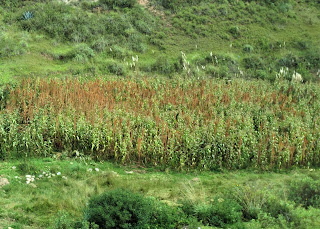























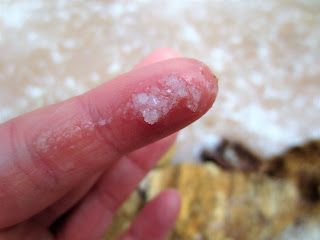






































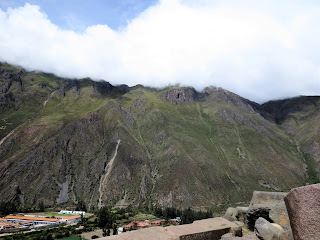

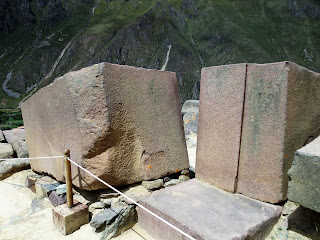










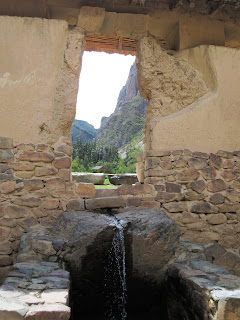






















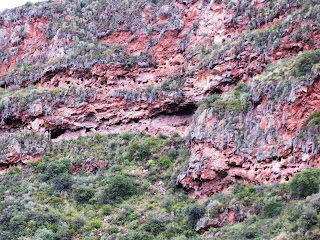













No comments:
Post a Comment